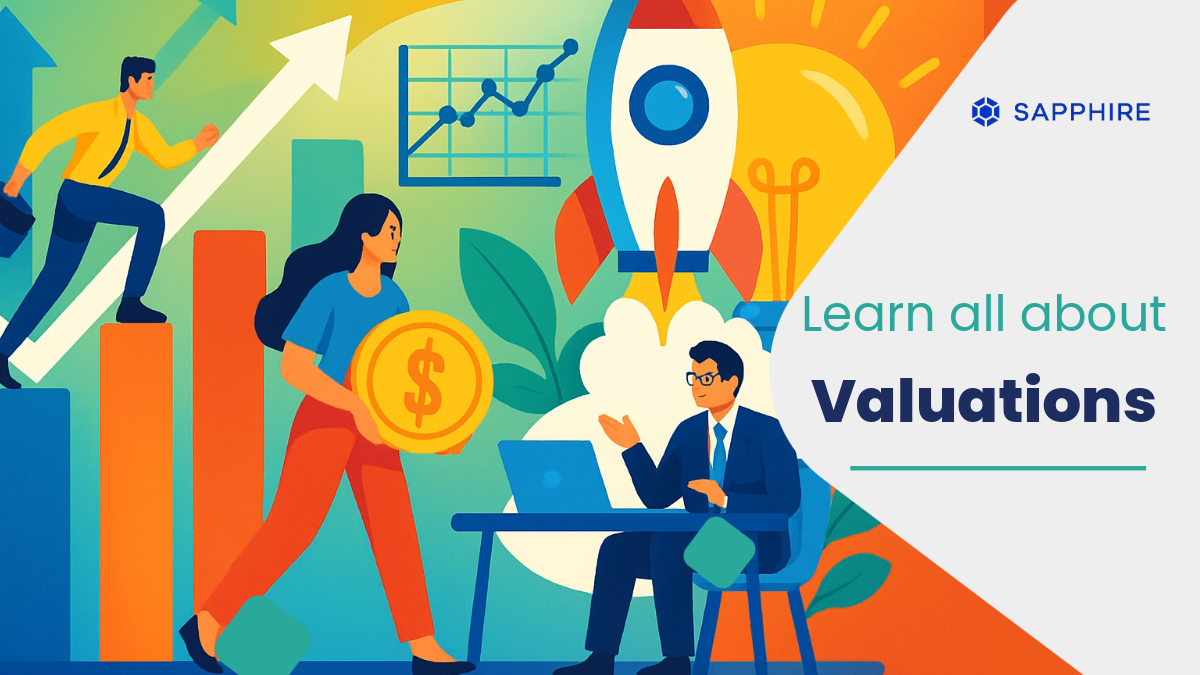At present, all we seem to be thinking about at Sapphire is valuations. Specifically, valuations of investee companies associated with AI.
Are we in an AI bubble?
For those of you old enough to remember, this feels remarkably like the internet bubble of the late 1990s all over again.
At that time, I was working in New York for PwC, and the exuberance was palpable.
The crash was painful. I was fortunate enough not to lose my job, but I know plenty of friends who did.
I fear we could be heading in this direction again.
It was therefore with keen interest that I listened to Nvidia’s Chief Executive, Jensen Huang, who was recently asked whether we’re in an AI bubble. His answer was immediate and emphatic:
“I don’t believe we’re in an AI bubble,” Huang told Bloomberg Television. “All of these different AI models we’re using, we’re using plenty of services and paying happily to do it.”
Investors cheered. Nvidia’s stock surged 5% to a record high of $201.03, pushing its valuation past the trillion-dollar mark. Huang’s confidence was infectious, backed by his claim that Nvidia’s latest chips could generate half a trillion dollars in revenue.
Below is a video summary of this article.
Nvidia’s Jensen Huang Says AI Isn’t a Bubble — But Is He Right?
Beneath the euphoria, questions remain. Gartner forecasts that AI-related spending will reach $1.5 trillion by 2025 and exceed $2 trillion by 2026, accounting for nearly 2% of global GDP. That kind of capital intensity inevitably invites my comparison to the dot-com boom, when investors confused technological progress with investment value.
Perhaps Huang is right; maybe there’s no bubble in chips. But across the broader AI ecosystem, in start-ups chasing valuations untethered from revenue, the signs of exuberance are hard to ignore. As David Einhorn of Greenlight Capital warned, “A tremendous amount of capital destruction is going to come through this cycle.”
At Sapphire, we see the same tension every day. The technology is transformational, but valuation discipline matters more than ever. This is where the International Private Equity and Venture Capital Valuation ("IPEV") Guidelines and the FCA’s Small AIFM regime play a crucial role, providing structure, governance, and realism in a market increasingly driven by momentum.
The Art and Science of Valuation
Valuing a start-up remains a mix of science and art. Established firms can be valued through audited earnings; early-stage ventures cannot. Venture investors, therefore, rely on financial techniques informed by judgement, anchored in IPEV’s principle that fair value must reflect market participant assumptions and current data.
At Sapphire, we remind founders that valuation is not simply a number; it is a reflection of potential, execution, and governance.
1) Stage and Market Opportunity
Investors assess both current demand and the potential to define new categories. The stage, pre-revenue, seed, or growth, determines valuation methodology. A pre-revenue company may possess valuable IP but no customers; a growth-stage firm should show traction and early revenues. IPEV recognises that pre-revenue valuation requires greater judgement around burn rate, milestones, and future funding prospects.
2) Quality of the Founding Team
Execution ability and leadership quality are the most decisive valuation factors. Team risk is directly priced: a great team yields a great valuation. OpenAI, led by Sam Altman, now generates roughly $12 billion in revenue and carries a valuation of nearly $500 billion, primarily driven by investor confidence in the founding team. As IPEV notes, management capability and business-model resilience must form part of fair value.
3) Traction and Growth Metrics
Momentum drives valuation. Early proof points, user growth, retention, ARR, engagement, and partnerships demonstrate scalability. In SaaS, valuations often hinge on ARR multiples of 5 to 10 times. IPEV requires calibration to ensure assumptions remain consistent with entry data and current performance.
4) Competitive Positioning and Defensibility
Defensibility defines durability. Proprietary technology, patents, and network effects underpin higher valuations. IPEV requires valuers to adjust comparables for liquidity, size, and growth potential to preserve objectivity.
5) Comparable Transactions and Market Benchmarks
Valuations are shaped by comparables, also known as “comps”. OpenAI and Anthropic, for example, are trading at 40 times and 46 times their respective revenue multiples. Whether those levels are sustainable is unclear. IPEV cautions that a recent transaction price is not automatically the fair value.
As Harvard Business Review observed (Is AI a Boom or a Bubble?, Paulo Carvão, October 2025), inflated AI deal multiples may resemble prior speculative cycles, reminding investors to recalibrate before extrapolating benchmarks.
6) Negotiations
Valuation is ultimately negotiated. It reflects market appetite and founder leverage. In exuberant markets, competition drives prices higher; in more challenging conditions, investors demand a higher equity stake. IPEV requires judgement rooted in market participant assumptions, excluding prices distorted by strategic or distressed motives.
7) Valuation in Practice. Some (but not all) Worked Examples
Standard venture valuation methods include:
- Venture Capital (VC) methods project an exit value and discount it by a required return (often 40 to 60% per annum).
Example: £25m exit in four years, discounted at 50% → post-money at £5m, pre-money at £2m, implying 60% investor ownership. - Comparable transactions apply market multiples, such as revenue or EBITDA.
Example: £122m in revenue times a 6.5 multiple equals a circa £800m valuation. - The Risk Factor Summation Method adjusts for management quality, product maturity, and competition.
- Discounted Cash Flow (DCF) is rarely used in venture capital, but it is conceptually valuable for sanity-checking extremes.
IPEV requires that each approach be calibrated and reviewed at every measurement date.
8) Multiple Rounds and Dilution
Funding typically occurs in tranches. Each round brings new investors, new rights, and dilution. In one example, a company raises £3 million at Series A and £2 million at Series B. The first investor pays £1.05 per share; the second, £2.36, reflecting progress and reduced risk.
IPEV requires valuation adjustments for each share class’s ranking and liquidity.
Founders should raise for 18–24 months of runway, not all at once.
9) Beyond Numbers: Building Investor Confidence
Valuation is grounded in trust and governance. Under the FCA guidelines, small AIFMs are required to have documented valuation policies, an independent review, and a consistent methodology. IPEV mirrors these principles: transparency, documentation, and calibration are essential to credibility.
10) The AI Example. Market Reality versus Hype
The MIT NANDA Initiative (2025) found that 95% of enterprise AI pilots failed to achieve measurable ROI due to unrealistic assumptions. The lesson: Valuations should reflect the realism of market participants. Even as chipmakers like Nvidia capture tangible value, much of the AI ecosystem remains speculative, with adoption rates still unproven.
11) How VCs Add Value Beyond Capital
Private equity firms take control, while venture capitalists add value through their influence and expertise. They contribute by:
- Enhancing management teams;
- Securing follow-on investors; and
- Connecting start-ups to customers and partners.
Top-tier firms such as Andreessen Horowitz have institutionalised this value-add approach, providing operating support, networks, and expertise that accelerate scale.
12) Conclusion
Valuing an early-stage company requires a blend of analytical discipline and informed intuition, with the IPEV Guidelines providing a framework for this process. For founders, understanding these drivers should assist with their fundraising strategy. For investors, it involves applying disciplined valuation safeguards that align with the FCA and IPEV standards. At Sapphire, we believe our investment practice is grounded in transparency, calibration, and governance, ensuring valuations reflect genuine market-based fair value.
Next Steps:
If you would like advice on how to perform a valuation, or how to set up an investment fund, such as a GP/LP fund or an EIS fund, or if you need an FCA authorised operator and manager to manage the fund, or need pricing and options, fill out this form, and we will be in touch right away.
Disclaimer:
This content is provided for information purposes only and does not constitute investment advice or any form of recommendation.


